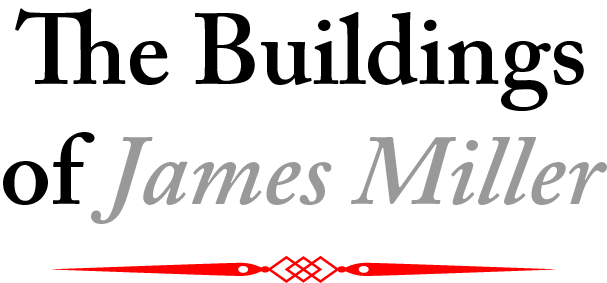James Miller
Introduction
Ask one hundred people to name a Scottish architect and many will probably say 'Charles Rennie Macintosh' - a smaller number might say 'Alexander ‘Greek’ Thompson' but how many will say 'James Miller' - probably not very many, and yet James Miller's work is equally important to the history of Scottish architecture in general and Glasgow in particular.
Walk around Glasgow City centre or travel around Scotland especially by train and you're never far away from a James Miller building - you just may not realise it.
Banks, churches, hospitals, railway stations, offices, cinemas and shops - James Miller was responsible for a huge range of public buildings all over Scotland and beyond, beautiful buildings, many still being used for their original purpose.
With no pretensions to being an academic work, and given the volume of Miller's work over a fifty year career, clearly not a complete guide, this website is my attempt to highlight some of the best work of this fine but relatively neglected architect.
Biography
The son of a farmer, James Miller was born in 1860 in Auchtergaven, Perthshire. His early childhood was spent in Little Cairnie, Forteviot and he was later educated at Perth Academy.
In 1877 he was articled to Andrew Heiton of Perth and at the end of his apprenticeship he spent some time with Hippolyte Blanc in Edinburgh before joining the Caledonian Railway engineering department in Perth. He was transferred to the Glasgow office in 1888, where he designed a number of stations including Fort Matilda, Gourock Pier and Bridge Street (1889) under the supervision of the engineer-in-chief, George Graham.
The quality of his work brought him to attention of the company and in 1890 Donald Alexander Matheson, a pupil of the Perth architect and civil engineer John Young, joined him in the office as resident engineer for the construction of the Glasgow Central Low Level lines.
In 1892, on winning the competition for Belmont Church in Hillhead James Miller set up his own full-time practice from an office at 223 West George Street.
His experience of railway work brought commissions in 1894 from his former employer the Caledonian Railway for stations on the West Highland Line including Crianlarich, Rannoch, Glenfinnan and Mallaig, also, in 1896 for the red sandstone, Jacobean-style St Enoch Subway station for the Glasgow Subway Company. One of his most impressive stations is Wemyss Bay with its magnificent curving glass and steel structure, still delighting the thousands who pass through on the way to the Rothsay ferry.
Miller’s railway work wasn’t confined to stations, two major railway hotels were also designed by Miller, the Turnberry for the Glasgow and South Western Railway in 1904 and Gleneagles in xxx. Miller designed the main industrial hall and concert hall for the Glasgow International Exhibition of 1901, also, on a more modest scale the Sunlight cottages.
Clydebank benefited from a new set of fine municipal buildings designed by Miller, the town hall and public baths opened with much celebration and a local holiday in 1902 and the fire station was in use from 1904. Clydebank public library, now on the site originally earmarked for the town hall wasn’t a Miller design, but that of a former pupil, A McInnes Gardner.
An American influence began to appear in Miller’s work following a 1902 fact-finding visit to the USA by Donald Matheson. An early example was Olympic House (1903), an office block on the corner of Queen Street and George Square. The American influence developed further following the appointment in 1918 of Richard M Gunn as chief draughtsman and designer, which resulted in designs such as the McLaren warehouse (1922) in George Square, and the impressive Head Office for the Union Bank of Scotland (1924) in St Vincent Street.
A number of Miller buildings attempted to counter the effects of industrial pollution prevalent in Glasgow at the time, the Anchor Line building on St Vincent Place has a façade of white faience tiles, the first time that a Scottish architect had used this material. Later buildings, the Commercial Bank of Scotland branches in Bothwell Street and West Nile Street used white Portland Stone.
Commissions for houses in Glasgow followed as a result of Miller’s involvement in the 1901 Glasgow International Exhibition, including 8 and 10 Lowther Terrace on Great Western Road.
Miller married Emelina Henrietta Crichton around 1898. George was the only son, but there were two daughters, Mabel and Muriel. James Miller retired when his son George died and he himself died at Randolphfield on 28 November 1947.
